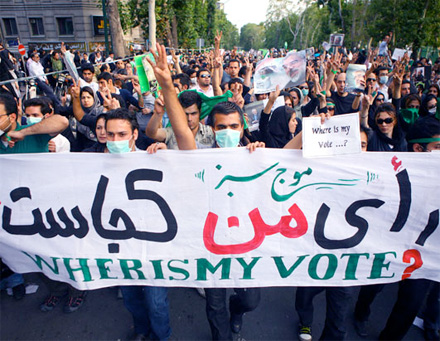
Two weeks ago Friday, in a dramatic turn of events, the 23-year reign of President Zine El Abidine Ben Ali in Tunisia came to an abrupt end. Images of the popular demonstrations that engulfed the country over the past few weeks bore resemblance to the protests that followed the disputed 2009 Iranian presidential election. The Green Movement of Iran, however, envisioned but never realized its promised land and succumbed to the repression of the Iranian theocracy. This is despite the similar nature of the two regimes.
Both republics, deemed ‘not-free’ by Freedom House, refer to universal suffrage for determining the country’s political direction. In various masquerade elections in Tunisia, President Ben Ali was repeatedly re-elected with 89 to 100 percent of the votes. In comparison to Tunisia, Iranian elections were more “open” and marked with degrees of pluralism, but the candidates are vetted by the omnipotent Guardian Council that serves as an exclusionary mechanism for those not aligned with the unelected crux of the clerical regime. Both police states are ruled by iron fisted regimes that frequently censor the internet, strong-arm journalists, oppress human rights activists, prosecute opponents, and execute dissidents.
The unprecedented events that shook the already fragile political spheres in Iran and Tunisia had different socio-political causes. In Tunisia, the revolt was sparked by the self-immolation of the 26-year old student-turned street merchant, Mohammed Bouazizi. He instantly became the symbol of the frustration that an entire generation of young Tunisians had endured. Protests spread like wildfire throughout the country. Initially, the protesters’ grievances centered on economic issues and reflected people’s ire with the rising prices of staples, increasing unemployment and rampant corruption. Over time, the economic demands transmuted into more destabilizing political clamors that called for the removal of the president’s grip from power and the prosecution of his wife, Leila Trabelsi, for corruption.
In Iran, however, the uprising had pure political motives. After the government announced the election victory of the incumbent president Mahmoud Ahmadinejad with 63 percent of the vote, the opposition accused the government of widespread fraud. The day after the election, spontaneous popular demonstrations broke out across the country. On June 15, 2009, three million demonstrators marched silently on the streets of Tehran, according to the city’s conservative mayor, Mohammad Bagher Ghalibaf. The wave of protest swept through the country with increasing momentum. The uprising started with the motto “Where is my vote?” which was rapidly transformed into chants of “Death to the dictator,” after the Supreme Leader, Ayatollah Ali Khamenei, endorsed Ahmadinejad’s re-election.
Nonetheless, the Tunisian “Jasmine Revolution” and the Iranian “Green Movement” shared striking similarities. In both countries, people from all strata of society partook in the protests, with youth and women at the forefront of the demonstrations. The tragic death of young students, like Neda Agha-Soltan in Iran and Mohammed Bouazizi in Tunisia, fueled the fervor against the oppressive governments. The mobile phones of citizen-journalists, not the professional cameras of Western correspondents, broadcasted the dramatic images of both rebellions. YouTube videos, Facebook pictures and Twitter slogans captured the imagination of millions around the world and served as testaments to the brutality of political orders bereft of mercy. During both movements, approximately 70 people reportedly lost their lives and many more were gravely injured.
The Iranian and Tunisian movements, however, are distinct in three ways. First, the rulers of Iran, comprised of former-revolutionaries who came to power by ousting the Western-backed Pahlavi monarchy, knew well that compromise under pressure only invites more pressure. The Supreme Leader did not show any sign of ceding control and ordered his massive suppression apparatus to nip the Green Movement in the bud. On the ruins of the Shah’s regime, the revolutionary leaders of Iran had established a republic of fear. The parallel security organizations and paramilitary squads, with fearsome capacity for cruelty, were designed to keep the Islamic Republic’s ship afloat. The guardians of the revolution moved fast to fill the prisons with political activists, shutdown cell phone networks, and expel foreign journalists. Conversely, the Tunisian leader came to power in a bloodless “medical coup” against the aging and senile President Bourguiba in 1987. As the protests erupted, he sacked ministers and promised change. Finally, he recited the Shah’s fatal words of “I heard the voice of your revolution” almost verbatim. The pronouncement was the death knell for his reign. Faced with the wrath of a nation, the army abandoned its tyrannical commander-in-chief and sealed his fate.
The second difference is that although both movements were spontaneous, amorphous, and had no decisive leader or party at their helm, Tunisian protestors were united in their overriding objective of bringing down President Ben Ali, whereas the Iranian protestors in the Green Movement did not share a unifying objective. Some demanded a recount of the vote, while others sought regime change. In the midst of protests, ideological discords and generational splits, ranging from the intensity of slogans to the legacy of Ayatollah Khomeini, were revealed. The irresolution of Iranian opposition leaders, who chose to abandon street protests in the face of a ruthless crackdown, compounded the incoherence of the movement. Sporadic political statements became the only page in the playbook of the ostensible standard-bearer of the movement, Mir Hossein Mousavi. Prudence replaced persistence and the Green Movement lost momentum. In the words of historian G.M. Tevelyan, the summer of 2009 became, “the turning point at which history failed to turn.” The Sisyphean struggle of the Iranian people for democracy had once again come to grief.
Lastly, the Tunisians knew they were alone in their audacious quest for freedom. The West tolerated Ben Ali’s autocracy and even portrayed it as a model of economic development and secularism that kept extremists at bay. The reaction of Western capitals and media to the Tunisian upheaval was at best timid. Without the sympathy of Western human rights enthusiasts and democracy promoters, Tunisians had to rely on their own courage and grit. The Iranians, however, were captivated by the global media’s extensive coverage of their movement and lost sight of the dark clouds gathering over them. They expected a flurry of international condemnations and pressure from human rights organizations that would collectively compel the regime to retreat. As the storm of the regime’s vicious clampdown started, they deserted the streets and hoped for redemption. The hype of the “Twitter Revolution” shifted the battle ground from the real world to the virtual sphere. Capitalizing on this shift, the Iranian regime unleashed its “Cyber Army” to bring down opposition websites, identify protest organizers, and disseminate misinformation. As the tides of the movement ebbed, optimism gave way to disheartening pessimism. By winter, the mirage of the “Iranian Berlin Wall” moment had dissipated.
President Ben Ali has fled to Saudi Arabia, and the reverberations of his departure are already being felt across the Arab world. The advent of democracy in Tunisia, however, is far from secured. The fate of the country is now in the hands of former Parliamentary Speaker, Fouad Mebazaa, and Prime Minister, Mohamed Ghannouchi, both cronies of the deposed president. In Iran, while the opposition faces political limbo, the government is confidently taking the country through “the biggest surgery of its economy in 50 years” by removing governmental subsidies. The Iranian and Tunisian Movements might not augur deep democratic change in the Middle East and North Africa, as the region’s tyrants may not be prepared to magically relinquish their old ways. Still, the political stability–and stagnation–that prevailed for a generation has been shaken.
First published in foreignpolicy.com.
AUTHOR
Ali Vaez, a former chief correspondent for Radio Free Europe in Switzerland, is an Iranian-born biomedical scientist. He is currently a candidate for a Master of International Public Policy at the Johns Hopkins University Paul H. Nitze School of Advanced International Studies (SAIS) in Washington, D.C. He can be reached at vaez@jhu.edu






